University Management Report: HRM, Patriarchy and Women
VerifiedAdded on 2023/01/11
|11
|3880
|90
Report
AI Summary
This report delves into Human Resource Management (HRM) and its strategic approach to managing people within an organization, aiming for competitive advantage. It contrasts HRM with traditional methods, emphasizing employee motivation, individual roles, and commitment. The report explores HRM policies, including equality and diversity, and differentiates between soft and hard HRM approaches. It examines the four main goals of HRM according to the Guest model: strategic integration, commitment, flexibility, and quality. Additionally, the report analyzes patriarchy as a social system where men hold primary power, and its impact on women, including gender inequality in the labor market. It discusses the theory of patriarchy, its flaws, and the influence of societal structures on women's roles and opportunities. The report also includes references to provide a comprehensive overview of these management concepts.

MANAGEMENT
Paraphrase This Document
Need a fresh take? Get an instant paraphrase of this document with our AI Paraphraser
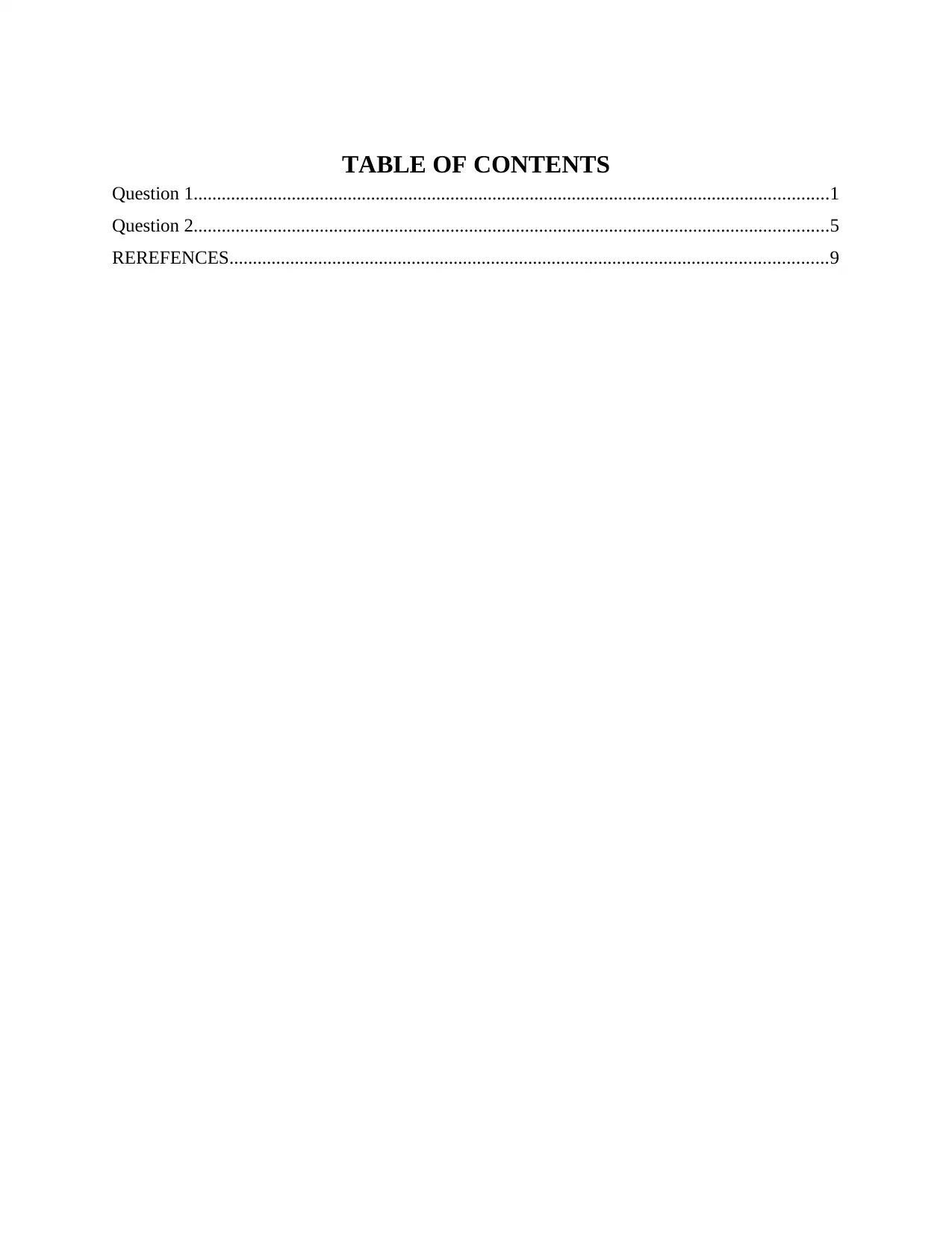
TABLE OF CONTENTS
Question 1........................................................................................................................................1
Question 2........................................................................................................................................5
REREFENCES................................................................................................................................9
Question 1........................................................................................................................................1
Question 2........................................................................................................................................5
REREFENCES................................................................................................................................9
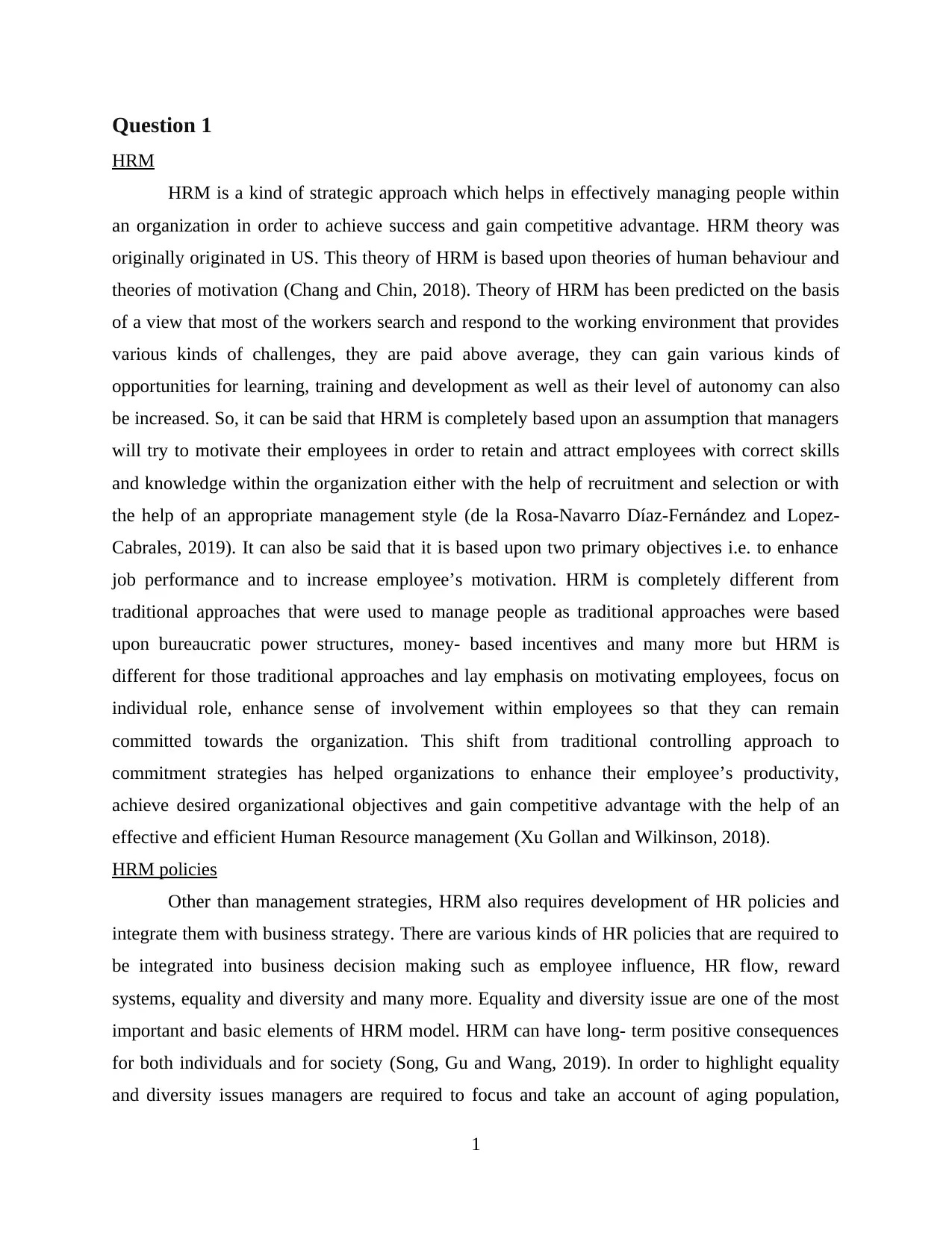
Question 1
HRM
HRM is a kind of strategic approach which helps in effectively managing people within
an organization in order to achieve success and gain competitive advantage. HRM theory was
originally originated in US. This theory of HRM is based upon theories of human behaviour and
theories of motivation (Chang and Chin, 2018). Theory of HRM has been predicted on the basis
of a view that most of the workers search and respond to the working environment that provides
various kinds of challenges, they are paid above average, they can gain various kinds of
opportunities for learning, training and development as well as their level of autonomy can also
be increased. So, it can be said that HRM is completely based upon an assumption that managers
will try to motivate their employees in order to retain and attract employees with correct skills
and knowledge within the organization either with the help of recruitment and selection or with
the help of an appropriate management style (de la Rosa-Navarro Díaz-Fernández and Lopez-
Cabrales, 2019). It can also be said that it is based upon two primary objectives i.e. to enhance
job performance and to increase employee’s motivation. HRM is completely different from
traditional approaches that were used to manage people as traditional approaches were based
upon bureaucratic power structures, money- based incentives and many more but HRM is
different for those traditional approaches and lay emphasis on motivating employees, focus on
individual role, enhance sense of involvement within employees so that they can remain
committed towards the organization. This shift from traditional controlling approach to
commitment strategies has helped organizations to enhance their employee’s productivity,
achieve desired organizational objectives and gain competitive advantage with the help of an
effective and efficient Human Resource management (Xu Gollan and Wilkinson, 2018).
HRM policies
Other than management strategies, HRM also requires development of HR policies and
integrate them with business strategy. There are various kinds of HR policies that are required to
be integrated into business decision making such as employee influence, HR flow, reward
systems, equality and diversity and many more. Equality and diversity issue are one of the most
important and basic elements of HRM model. HRM can have long- term positive consequences
for both individuals and for society (Song, Gu and Wang, 2019). In order to highlight equality
and diversity issues managers are required to focus and take an account of aging population,
1
HRM
HRM is a kind of strategic approach which helps in effectively managing people within
an organization in order to achieve success and gain competitive advantage. HRM theory was
originally originated in US. This theory of HRM is based upon theories of human behaviour and
theories of motivation (Chang and Chin, 2018). Theory of HRM has been predicted on the basis
of a view that most of the workers search and respond to the working environment that provides
various kinds of challenges, they are paid above average, they can gain various kinds of
opportunities for learning, training and development as well as their level of autonomy can also
be increased. So, it can be said that HRM is completely based upon an assumption that managers
will try to motivate their employees in order to retain and attract employees with correct skills
and knowledge within the organization either with the help of recruitment and selection or with
the help of an appropriate management style (de la Rosa-Navarro Díaz-Fernández and Lopez-
Cabrales, 2019). It can also be said that it is based upon two primary objectives i.e. to enhance
job performance and to increase employee’s motivation. HRM is completely different from
traditional approaches that were used to manage people as traditional approaches were based
upon bureaucratic power structures, money- based incentives and many more but HRM is
different for those traditional approaches and lay emphasis on motivating employees, focus on
individual role, enhance sense of involvement within employees so that they can remain
committed towards the organization. This shift from traditional controlling approach to
commitment strategies has helped organizations to enhance their employee’s productivity,
achieve desired organizational objectives and gain competitive advantage with the help of an
effective and efficient Human Resource management (Xu Gollan and Wilkinson, 2018).
HRM policies
Other than management strategies, HRM also requires development of HR policies and
integrate them with business strategy. There are various kinds of HR policies that are required to
be integrated into business decision making such as employee influence, HR flow, reward
systems, equality and diversity and many more. Equality and diversity issue are one of the most
important and basic elements of HRM model. HRM can have long- term positive consequences
for both individuals and for society (Song, Gu and Wang, 2019). In order to highlight equality
and diversity issues managers are required to focus and take an account of aging population,
1
⊘ This is a preview!⊘
Do you want full access?
Subscribe today to unlock all pages.

Trusted by 1+ million students worldwide
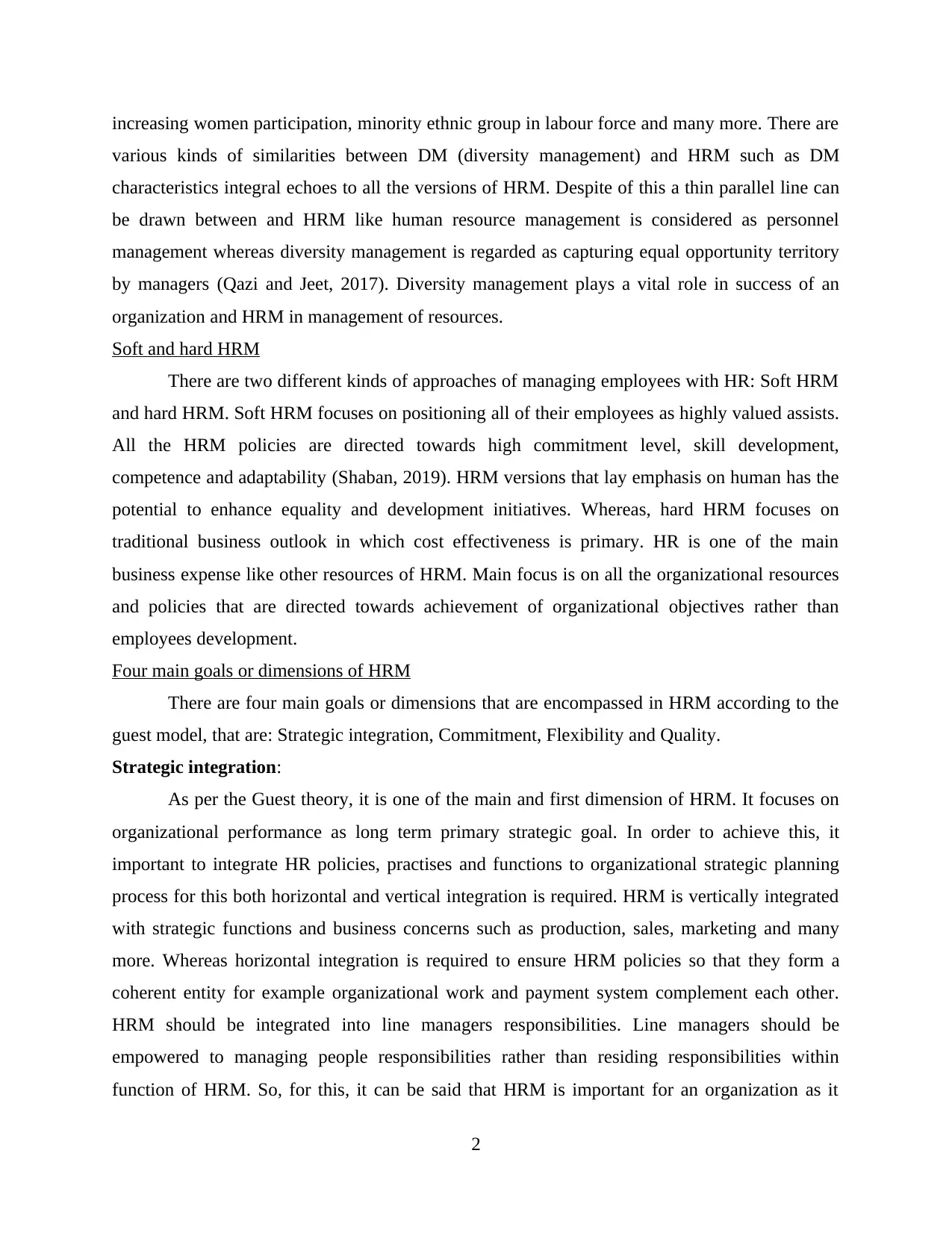
increasing women participation, minority ethnic group in labour force and many more. There are
various kinds of similarities between DM (diversity management) and HRM such as DM
characteristics integral echoes to all the versions of HRM. Despite of this a thin parallel line can
be drawn between and HRM like human resource management is considered as personnel
management whereas diversity management is regarded as capturing equal opportunity territory
by managers (Qazi and Jeet, 2017). Diversity management plays a vital role in success of an
organization and HRM in management of resources.
Soft and hard HRM
There are two different kinds of approaches of managing employees with HR: Soft HRM
and hard HRM. Soft HRM focuses on positioning all of their employees as highly valued assists.
All the HRM policies are directed towards high commitment level, skill development,
competence and adaptability (Shaban, 2019). HRM versions that lay emphasis on human has the
potential to enhance equality and development initiatives. Whereas, hard HRM focuses on
traditional business outlook in which cost effectiveness is primary. HR is one of the main
business expense like other resources of HRM. Main focus is on all the organizational resources
and policies that are directed towards achievement of organizational objectives rather than
employees development.
Four main goals or dimensions of HRM
There are four main goals or dimensions that are encompassed in HRM according to the
guest model, that are: Strategic integration, Commitment, Flexibility and Quality.
Strategic integration:
As per the Guest theory, it is one of the main and first dimension of HRM. It focuses on
organizational performance as long term primary strategic goal. In order to achieve this, it
important to integrate HR policies, practises and functions to organizational strategic planning
process for this both horizontal and vertical integration is required. HRM is vertically integrated
with strategic functions and business concerns such as production, sales, marketing and many
more. Whereas horizontal integration is required to ensure HRM policies so that they form a
coherent entity for example organizational work and payment system complement each other.
HRM should be integrated into line managers responsibilities. Line managers should be
empowered to managing people responsibilities rather than residing responsibilities within
function of HRM. So, for this, it can be said that HRM is important for an organization as it
2
various kinds of similarities between DM (diversity management) and HRM such as DM
characteristics integral echoes to all the versions of HRM. Despite of this a thin parallel line can
be drawn between and HRM like human resource management is considered as personnel
management whereas diversity management is regarded as capturing equal opportunity territory
by managers (Qazi and Jeet, 2017). Diversity management plays a vital role in success of an
organization and HRM in management of resources.
Soft and hard HRM
There are two different kinds of approaches of managing employees with HR: Soft HRM
and hard HRM. Soft HRM focuses on positioning all of their employees as highly valued assists.
All the HRM policies are directed towards high commitment level, skill development,
competence and adaptability (Shaban, 2019). HRM versions that lay emphasis on human has the
potential to enhance equality and development initiatives. Whereas, hard HRM focuses on
traditional business outlook in which cost effectiveness is primary. HR is one of the main
business expense like other resources of HRM. Main focus is on all the organizational resources
and policies that are directed towards achievement of organizational objectives rather than
employees development.
Four main goals or dimensions of HRM
There are four main goals or dimensions that are encompassed in HRM according to the
guest model, that are: Strategic integration, Commitment, Flexibility and Quality.
Strategic integration:
As per the Guest theory, it is one of the main and first dimension of HRM. It focuses on
organizational performance as long term primary strategic goal. In order to achieve this, it
important to integrate HR policies, practises and functions to organizational strategic planning
process for this both horizontal and vertical integration is required. HRM is vertically integrated
with strategic functions and business concerns such as production, sales, marketing and many
more. Whereas horizontal integration is required to ensure HRM policies so that they form a
coherent entity for example organizational work and payment system complement each other.
HRM should be integrated into line managers responsibilities. Line managers should be
empowered to managing people responsibilities rather than residing responsibilities within
function of HRM. So, for this, it can be said that HRM is important for an organization as it
2
Paraphrase This Document
Need a fresh take? Get an instant paraphrase of this document with our AI Paraphraser
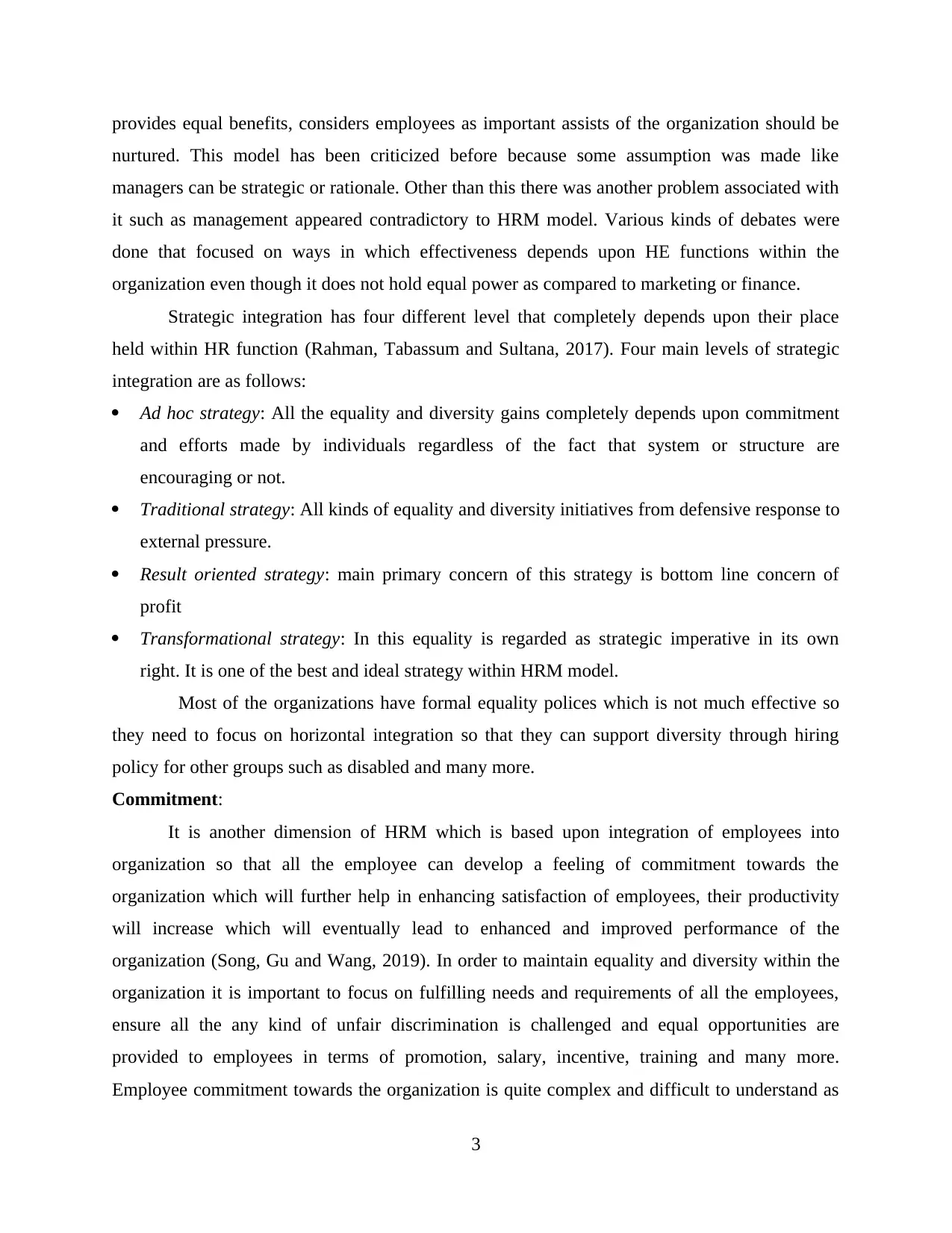
provides equal benefits, considers employees as important assists of the organization should be
nurtured. This model has been criticized before because some assumption was made like
managers can be strategic or rationale. Other than this there was another problem associated with
it such as management appeared contradictory to HRM model. Various kinds of debates were
done that focused on ways in which effectiveness depends upon HE functions within the
organization even though it does not hold equal power as compared to marketing or finance.
Strategic integration has four different level that completely depends upon their place
held within HR function (Rahman, Tabassum and Sultana, 2017). Four main levels of strategic
integration are as follows:
Ad hoc strategy: All the equality and diversity gains completely depends upon commitment
and efforts made by individuals regardless of the fact that system or structure are
encouraging or not.
Traditional strategy: All kinds of equality and diversity initiatives from defensive response to
external pressure.
Result oriented strategy: main primary concern of this strategy is bottom line concern of
profit
Transformational strategy: In this equality is regarded as strategic imperative in its own
right. It is one of the best and ideal strategy within HRM model.
Most of the organizations have formal equality polices which is not much effective so
they need to focus on horizontal integration so that they can support diversity through hiring
policy for other groups such as disabled and many more.
Commitment:
It is another dimension of HRM which is based upon integration of employees into
organization so that all the employee can develop a feeling of commitment towards the
organization which will further help in enhancing satisfaction of employees, their productivity
will increase which will eventually lead to enhanced and improved performance of the
organization (Song, Gu and Wang, 2019). In order to maintain equality and diversity within the
organization it is important to focus on fulfilling needs and requirements of all the employees,
ensure all the any kind of unfair discrimination is challenged and equal opportunities are
provided to employees in terms of promotion, salary, incentive, training and many more.
Employee commitment towards the organization is quite complex and difficult to understand as
3
nurtured. This model has been criticized before because some assumption was made like
managers can be strategic or rationale. Other than this there was another problem associated with
it such as management appeared contradictory to HRM model. Various kinds of debates were
done that focused on ways in which effectiveness depends upon HE functions within the
organization even though it does not hold equal power as compared to marketing or finance.
Strategic integration has four different level that completely depends upon their place
held within HR function (Rahman, Tabassum and Sultana, 2017). Four main levels of strategic
integration are as follows:
Ad hoc strategy: All the equality and diversity gains completely depends upon commitment
and efforts made by individuals regardless of the fact that system or structure are
encouraging or not.
Traditional strategy: All kinds of equality and diversity initiatives from defensive response to
external pressure.
Result oriented strategy: main primary concern of this strategy is bottom line concern of
profit
Transformational strategy: In this equality is regarded as strategic imperative in its own
right. It is one of the best and ideal strategy within HRM model.
Most of the organizations have formal equality polices which is not much effective so
they need to focus on horizontal integration so that they can support diversity through hiring
policy for other groups such as disabled and many more.
Commitment:
It is another dimension of HRM which is based upon integration of employees into
organization so that all the employee can develop a feeling of commitment towards the
organization which will further help in enhancing satisfaction of employees, their productivity
will increase which will eventually lead to enhanced and improved performance of the
organization (Song, Gu and Wang, 2019). In order to maintain equality and diversity within the
organization it is important to focus on fulfilling needs and requirements of all the employees,
ensure all the any kind of unfair discrimination is challenged and equal opportunities are
provided to employees in terms of promotion, salary, incentive, training and many more.
Employee commitment towards the organization is quite complex and difficult to understand as
3
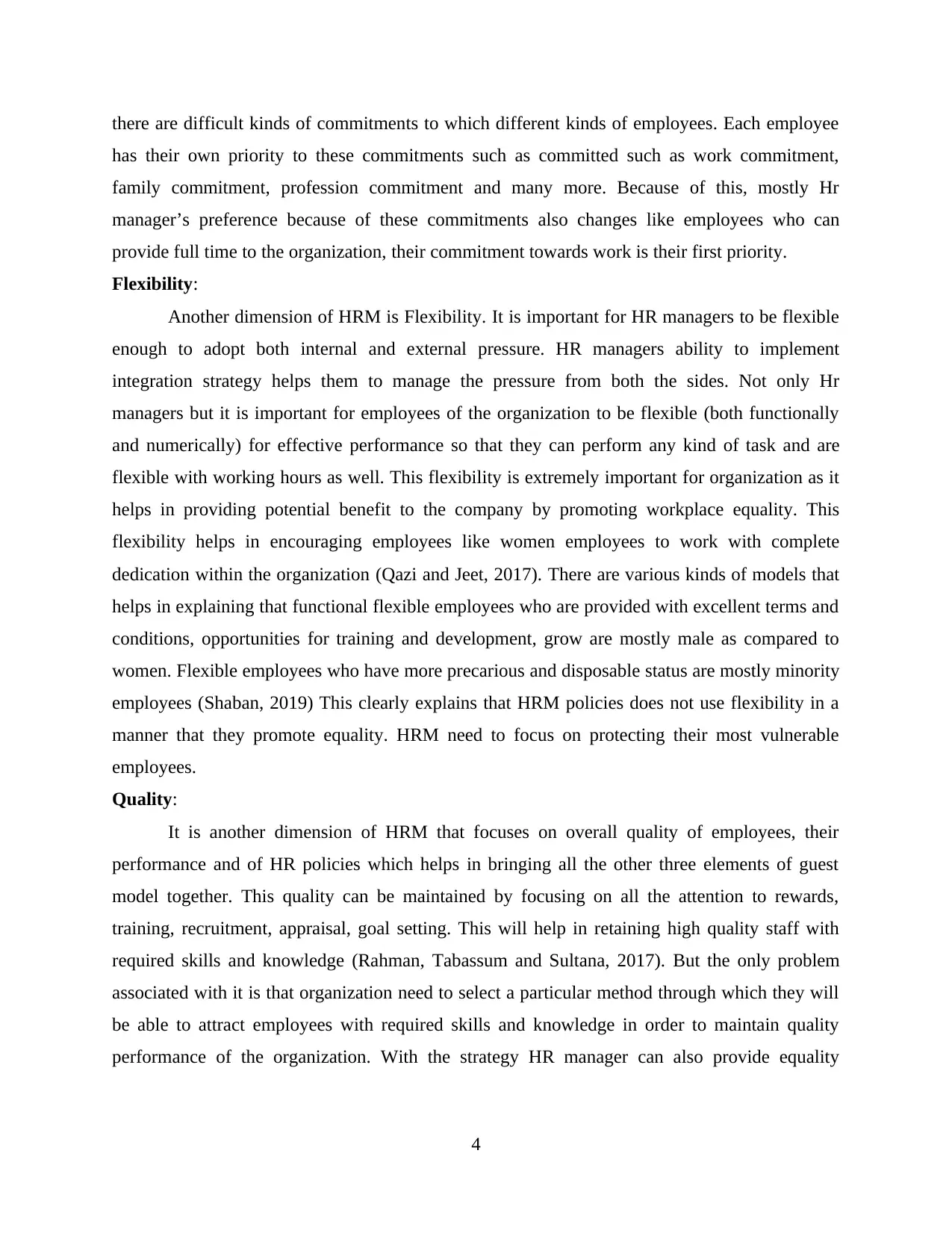
there are difficult kinds of commitments to which different kinds of employees. Each employee
has their own priority to these commitments such as committed such as work commitment,
family commitment, profession commitment and many more. Because of this, mostly Hr
manager’s preference because of these commitments also changes like employees who can
provide full time to the organization, their commitment towards work is their first priority.
Flexibility:
Another dimension of HRM is Flexibility. It is important for HR managers to be flexible
enough to adopt both internal and external pressure. HR managers ability to implement
integration strategy helps them to manage the pressure from both the sides. Not only Hr
managers but it is important for employees of the organization to be flexible (both functionally
and numerically) for effective performance so that they can perform any kind of task and are
flexible with working hours as well. This flexibility is extremely important for organization as it
helps in providing potential benefit to the company by promoting workplace equality. This
flexibility helps in encouraging employees like women employees to work with complete
dedication within the organization (Qazi and Jeet, 2017). There are various kinds of models that
helps in explaining that functional flexible employees who are provided with excellent terms and
conditions, opportunities for training and development, grow are mostly male as compared to
women. Flexible employees who have more precarious and disposable status are mostly minority
employees (Shaban, 2019) This clearly explains that HRM policies does not use flexibility in a
manner that they promote equality. HRM need to focus on protecting their most vulnerable
employees.
Quality:
It is another dimension of HRM that focuses on overall quality of employees, their
performance and of HR policies which helps in bringing all the other three elements of guest
model together. This quality can be maintained by focusing on all the attention to rewards,
training, recruitment, appraisal, goal setting. This will help in retaining high quality staff with
required skills and knowledge (Rahman, Tabassum and Sultana, 2017). But the only problem
associated with it is that organization need to select a particular method through which they will
be able to attract employees with required skills and knowledge in order to maintain quality
performance of the organization. With the strategy HR manager can also provide equality
4
has their own priority to these commitments such as committed such as work commitment,
family commitment, profession commitment and many more. Because of this, mostly Hr
manager’s preference because of these commitments also changes like employees who can
provide full time to the organization, their commitment towards work is their first priority.
Flexibility:
Another dimension of HRM is Flexibility. It is important for HR managers to be flexible
enough to adopt both internal and external pressure. HR managers ability to implement
integration strategy helps them to manage the pressure from both the sides. Not only Hr
managers but it is important for employees of the organization to be flexible (both functionally
and numerically) for effective performance so that they can perform any kind of task and are
flexible with working hours as well. This flexibility is extremely important for organization as it
helps in providing potential benefit to the company by promoting workplace equality. This
flexibility helps in encouraging employees like women employees to work with complete
dedication within the organization (Qazi and Jeet, 2017). There are various kinds of models that
helps in explaining that functional flexible employees who are provided with excellent terms and
conditions, opportunities for training and development, grow are mostly male as compared to
women. Flexible employees who have more precarious and disposable status are mostly minority
employees (Shaban, 2019) This clearly explains that HRM policies does not use flexibility in a
manner that they promote equality. HRM need to focus on protecting their most vulnerable
employees.
Quality:
It is another dimension of HRM that focuses on overall quality of employees, their
performance and of HR policies which helps in bringing all the other three elements of guest
model together. This quality can be maintained by focusing on all the attention to rewards,
training, recruitment, appraisal, goal setting. This will help in retaining high quality staff with
required skills and knowledge (Rahman, Tabassum and Sultana, 2017). But the only problem
associated with it is that organization need to select a particular method through which they will
be able to attract employees with required skills and knowledge in order to maintain quality
performance of the organization. With the strategy HR manager can also provide equality
4
⊘ This is a preview!⊘
Do you want full access?
Subscribe today to unlock all pages.

Trusted by 1+ million students worldwide
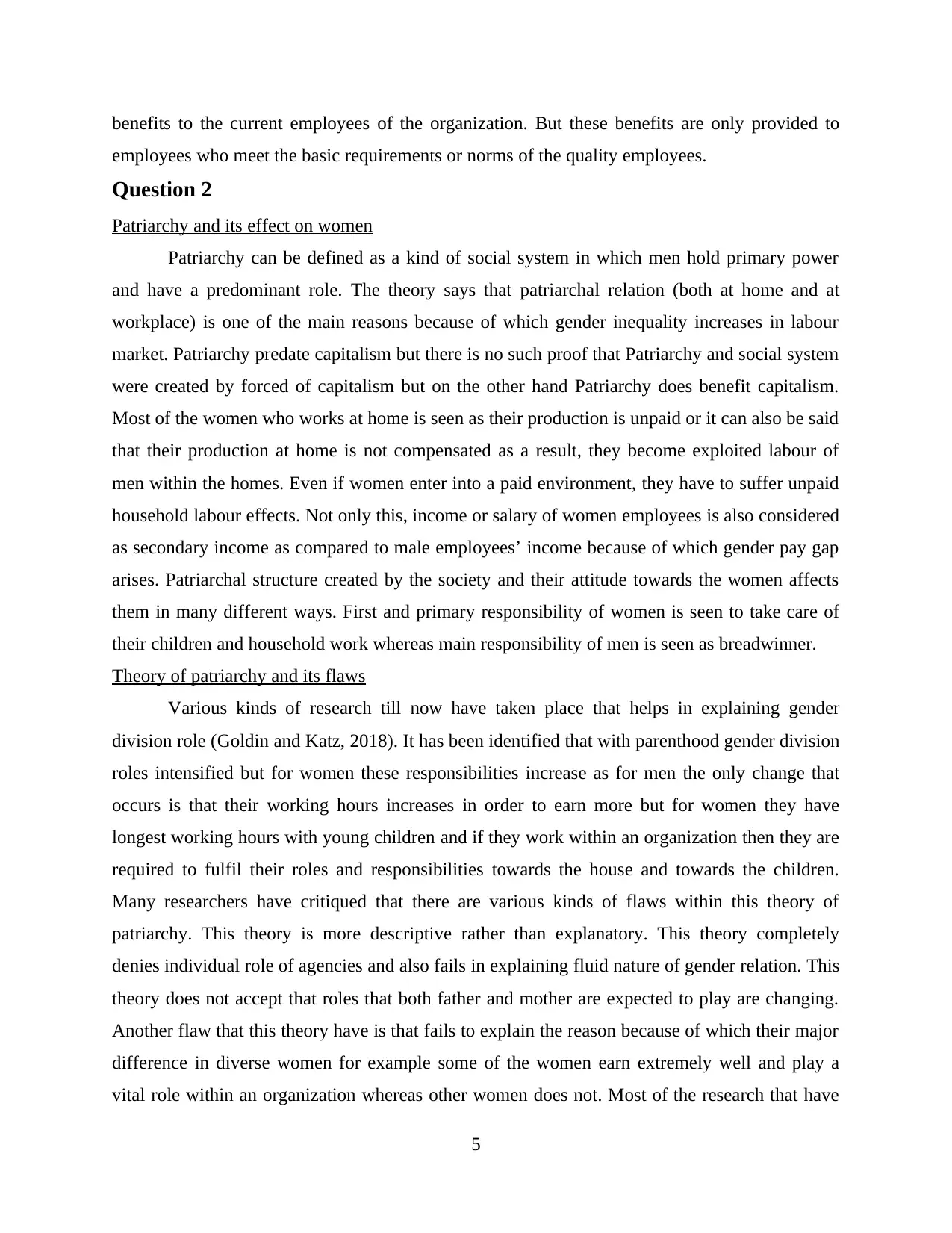
benefits to the current employees of the organization. But these benefits are only provided to
employees who meet the basic requirements or norms of the quality employees.
Question 2
Patriarchy and its effect on women
Patriarchy can be defined as a kind of social system in which men hold primary power
and have a predominant role. The theory says that patriarchal relation (both at home and at
workplace) is one of the main reasons because of which gender inequality increases in labour
market. Patriarchy predate capitalism but there is no such proof that Patriarchy and social system
were created by forced of capitalism but on the other hand Patriarchy does benefit capitalism.
Most of the women who works at home is seen as their production is unpaid or it can also be said
that their production at home is not compensated as a result, they become exploited labour of
men within the homes. Even if women enter into a paid environment, they have to suffer unpaid
household labour effects. Not only this, income or salary of women employees is also considered
as secondary income as compared to male employees’ income because of which gender pay gap
arises. Patriarchal structure created by the society and their attitude towards the women affects
them in many different ways. First and primary responsibility of women is seen to take care of
their children and household work whereas main responsibility of men is seen as breadwinner.
Theory of patriarchy and its flaws
Various kinds of research till now have taken place that helps in explaining gender
division role (Goldin and Katz, 2018). It has been identified that with parenthood gender division
roles intensified but for women these responsibilities increase as for men the only change that
occurs is that their working hours increases in order to earn more but for women they have
longest working hours with young children and if they work within an organization then they are
required to fulfil their roles and responsibilities towards the house and towards the children.
Many researchers have critiqued that there are various kinds of flaws within this theory of
patriarchy. This theory is more descriptive rather than explanatory. This theory completely
denies individual role of agencies and also fails in explaining fluid nature of gender relation. This
theory does not accept that roles that both father and mother are expected to play are changing.
Another flaw that this theory have is that fails to explain the reason because of which their major
difference in diverse women for example some of the women earn extremely well and play a
vital role within an organization whereas other women does not. Most of the research that have
5
employees who meet the basic requirements or norms of the quality employees.
Question 2
Patriarchy and its effect on women
Patriarchy can be defined as a kind of social system in which men hold primary power
and have a predominant role. The theory says that patriarchal relation (both at home and at
workplace) is one of the main reasons because of which gender inequality increases in labour
market. Patriarchy predate capitalism but there is no such proof that Patriarchy and social system
were created by forced of capitalism but on the other hand Patriarchy does benefit capitalism.
Most of the women who works at home is seen as their production is unpaid or it can also be said
that their production at home is not compensated as a result, they become exploited labour of
men within the homes. Even if women enter into a paid environment, they have to suffer unpaid
household labour effects. Not only this, income or salary of women employees is also considered
as secondary income as compared to male employees’ income because of which gender pay gap
arises. Patriarchal structure created by the society and their attitude towards the women affects
them in many different ways. First and primary responsibility of women is seen to take care of
their children and household work whereas main responsibility of men is seen as breadwinner.
Theory of patriarchy and its flaws
Various kinds of research till now have taken place that helps in explaining gender
division role (Goldin and Katz, 2018). It has been identified that with parenthood gender division
roles intensified but for women these responsibilities increase as for men the only change that
occurs is that their working hours increases in order to earn more but for women they have
longest working hours with young children and if they work within an organization then they are
required to fulfil their roles and responsibilities towards the house and towards the children.
Many researchers have critiqued that there are various kinds of flaws within this theory of
patriarchy. This theory is more descriptive rather than explanatory. This theory completely
denies individual role of agencies and also fails in explaining fluid nature of gender relation. This
theory does not accept that roles that both father and mother are expected to play are changing.
Another flaw that this theory have is that fails to explain the reason because of which their major
difference in diverse women for example some of the women earn extremely well and play a
vital role within an organization whereas other women does not. Most of the research that have
5
Paraphrase This Document
Need a fresh take? Get an instant paraphrase of this document with our AI Paraphraser
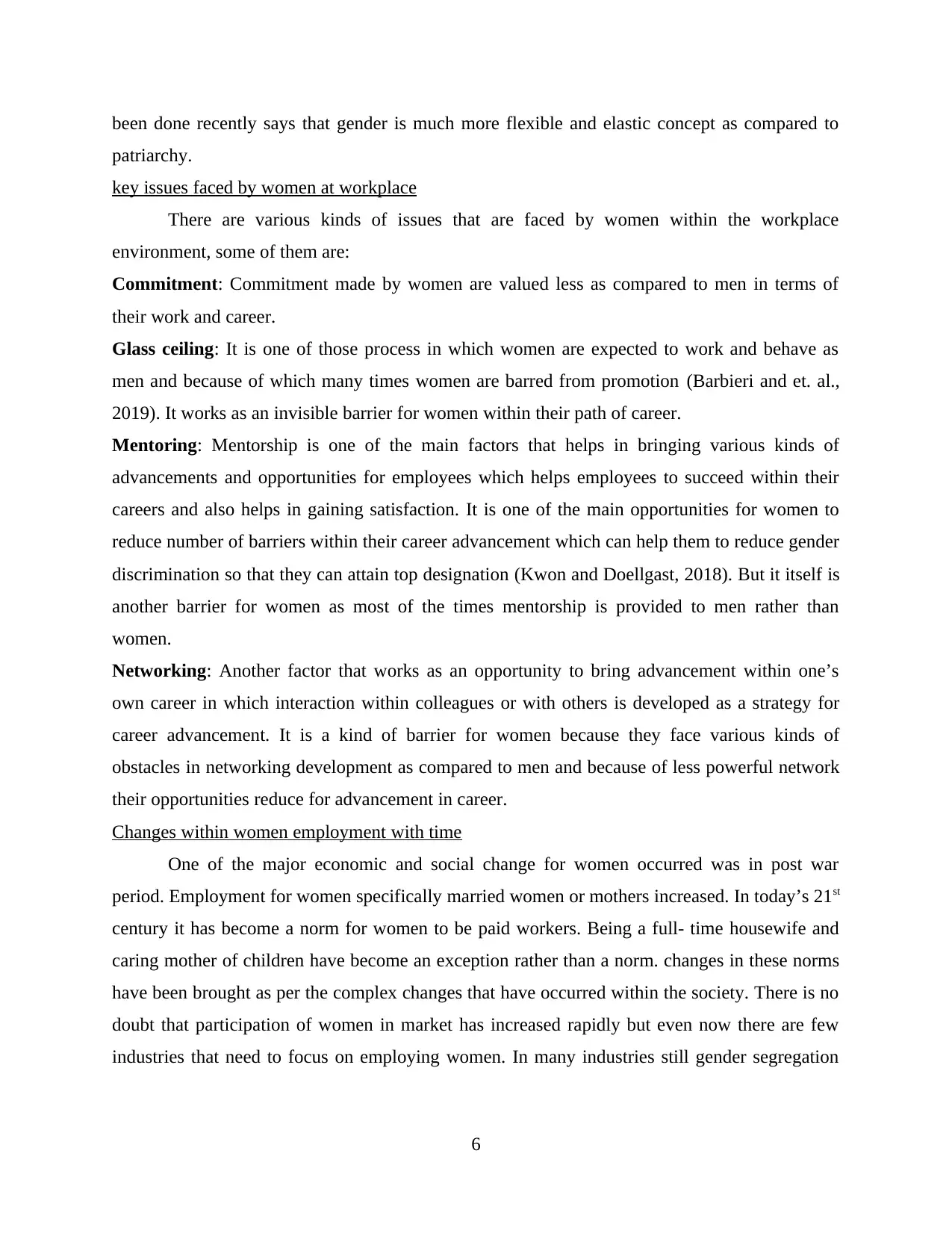
been done recently says that gender is much more flexible and elastic concept as compared to
patriarchy.
key issues faced by women at workplace
There are various kinds of issues that are faced by women within the workplace
environment, some of them are:
Commitment: Commitment made by women are valued less as compared to men in terms of
their work and career.
Glass ceiling: It is one of those process in which women are expected to work and behave as
men and because of which many times women are barred from promotion (Barbieri and et. al.,
2019). It works as an invisible barrier for women within their path of career.
Mentoring: Mentorship is one of the main factors that helps in bringing various kinds of
advancements and opportunities for employees which helps employees to succeed within their
careers and also helps in gaining satisfaction. It is one of the main opportunities for women to
reduce number of barriers within their career advancement which can help them to reduce gender
discrimination so that they can attain top designation (Kwon and Doellgast, 2018). But it itself is
another barrier for women as most of the times mentorship is provided to men rather than
women.
Networking: Another factor that works as an opportunity to bring advancement within one’s
own career in which interaction within colleagues or with others is developed as a strategy for
career advancement. It is a kind of barrier for women because they face various kinds of
obstacles in networking development as compared to men and because of less powerful network
their opportunities reduce for advancement in career.
Changes within women employment with time
One of the major economic and social change for women occurred was in post war
period. Employment for women specifically married women or mothers increased. In today’s 21st
century it has become a norm for women to be paid workers. Being a full- time housewife and
caring mother of children have become an exception rather than a norm. changes in these norms
have been brought as per the complex changes that have occurred within the society. There is no
doubt that participation of women in market has increased rapidly but even now there are few
industries that need to focus on employing women. In many industries still gender segregation
6
patriarchy.
key issues faced by women at workplace
There are various kinds of issues that are faced by women within the workplace
environment, some of them are:
Commitment: Commitment made by women are valued less as compared to men in terms of
their work and career.
Glass ceiling: It is one of those process in which women are expected to work and behave as
men and because of which many times women are barred from promotion (Barbieri and et. al.,
2019). It works as an invisible barrier for women within their path of career.
Mentoring: Mentorship is one of the main factors that helps in bringing various kinds of
advancements and opportunities for employees which helps employees to succeed within their
careers and also helps in gaining satisfaction. It is one of the main opportunities for women to
reduce number of barriers within their career advancement which can help them to reduce gender
discrimination so that they can attain top designation (Kwon and Doellgast, 2018). But it itself is
another barrier for women as most of the times mentorship is provided to men rather than
women.
Networking: Another factor that works as an opportunity to bring advancement within one’s
own career in which interaction within colleagues or with others is developed as a strategy for
career advancement. It is a kind of barrier for women because they face various kinds of
obstacles in networking development as compared to men and because of less powerful network
their opportunities reduce for advancement in career.
Changes within women employment with time
One of the major economic and social change for women occurred was in post war
period. Employment for women specifically married women or mothers increased. In today’s 21st
century it has become a norm for women to be paid workers. Being a full- time housewife and
caring mother of children have become an exception rather than a norm. changes in these norms
have been brought as per the complex changes that have occurred within the society. There is no
doubt that participation of women in market has increased rapidly but even now there are few
industries that need to focus on employing women. In many industries still gender segregation
6
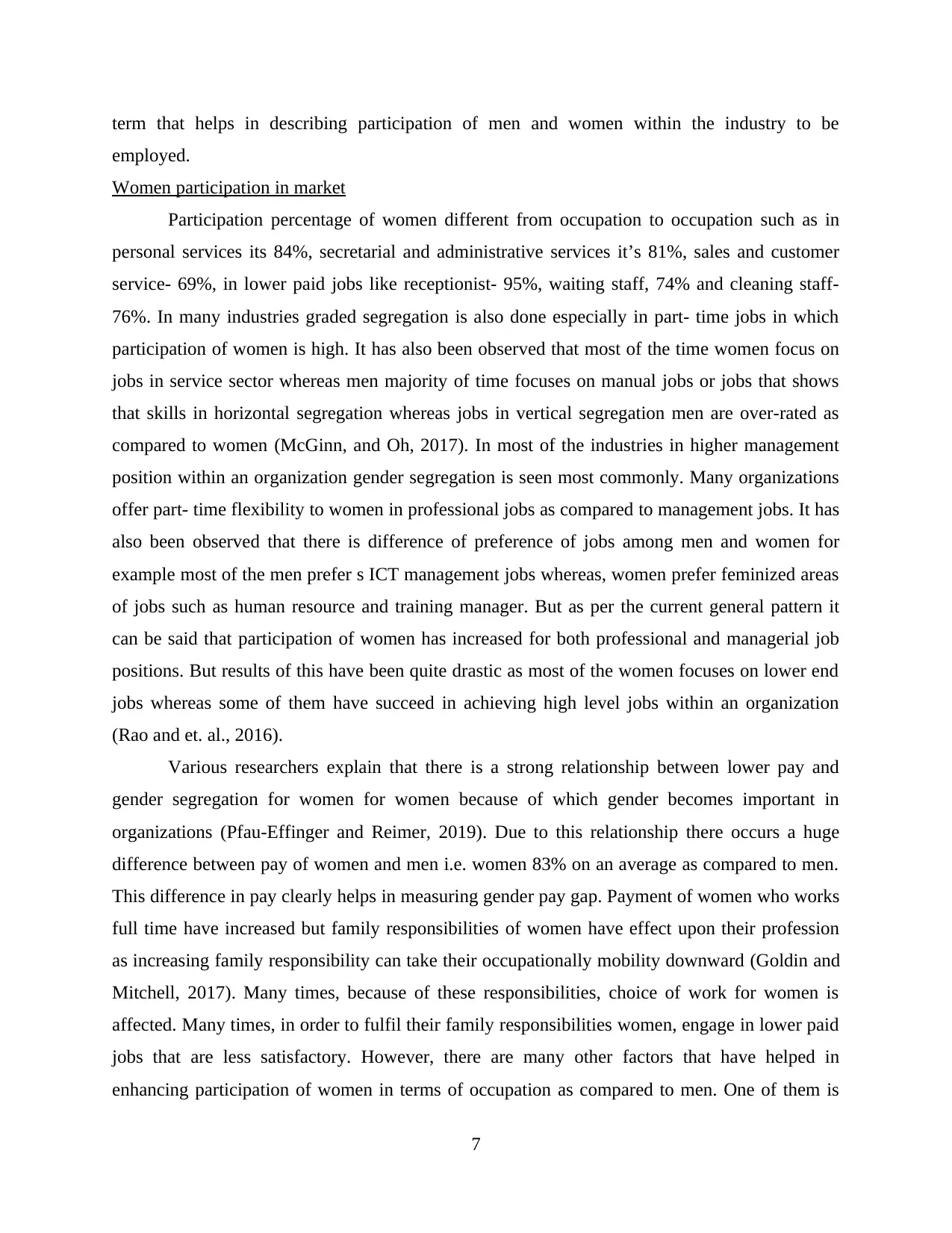
term that helps in describing participation of men and women within the industry to be
employed.
Women participation in market
Participation percentage of women different from occupation to occupation such as in
personal services its 84%, secretarial and administrative services it’s 81%, sales and customer
service- 69%, in lower paid jobs like receptionist- 95%, waiting staff, 74% and cleaning staff-
76%. In many industries graded segregation is also done especially in part- time jobs in which
participation of women is high. It has also been observed that most of the time women focus on
jobs in service sector whereas men majority of time focuses on manual jobs or jobs that shows
that skills in horizontal segregation whereas jobs in vertical segregation men are over-rated as
compared to women (McGinn, and Oh, 2017). In most of the industries in higher management
position within an organization gender segregation is seen most commonly. Many organizations
offer part- time flexibility to women in professional jobs as compared to management jobs. It has
also been observed that there is difference of preference of jobs among men and women for
example most of the men prefer s ICT management jobs whereas, women prefer feminized areas
of jobs such as human resource and training manager. But as per the current general pattern it
can be said that participation of women has increased for both professional and managerial job
positions. But results of this have been quite drastic as most of the women focuses on lower end
jobs whereas some of them have succeed in achieving high level jobs within an organization
(Rao and et. al., 2016).
Various researchers explain that there is a strong relationship between lower pay and
gender segregation for women for women because of which gender becomes important in
organizations (Pfau-Effinger and Reimer, 2019). Due to this relationship there occurs a huge
difference between pay of women and men i.e. women 83% on an average as compared to men.
This difference in pay clearly helps in measuring gender pay gap. Payment of women who works
full time have increased but family responsibilities of women have effect upon their profession
as increasing family responsibility can take their occupationally mobility downward (Goldin and
Mitchell, 2017). Many times, because of these responsibilities, choice of work for women is
affected. Many times, in order to fulfil their family responsibilities women, engage in lower paid
jobs that are less satisfactory. However, there are many other factors that have helped in
enhancing participation of women in terms of occupation as compared to men. One of them is
7
employed.
Women participation in market
Participation percentage of women different from occupation to occupation such as in
personal services its 84%, secretarial and administrative services it’s 81%, sales and customer
service- 69%, in lower paid jobs like receptionist- 95%, waiting staff, 74% and cleaning staff-
76%. In many industries graded segregation is also done especially in part- time jobs in which
participation of women is high. It has also been observed that most of the time women focus on
jobs in service sector whereas men majority of time focuses on manual jobs or jobs that shows
that skills in horizontal segregation whereas jobs in vertical segregation men are over-rated as
compared to women (McGinn, and Oh, 2017). In most of the industries in higher management
position within an organization gender segregation is seen most commonly. Many organizations
offer part- time flexibility to women in professional jobs as compared to management jobs. It has
also been observed that there is difference of preference of jobs among men and women for
example most of the men prefer s ICT management jobs whereas, women prefer feminized areas
of jobs such as human resource and training manager. But as per the current general pattern it
can be said that participation of women has increased for both professional and managerial job
positions. But results of this have been quite drastic as most of the women focuses on lower end
jobs whereas some of them have succeed in achieving high level jobs within an organization
(Rao and et. al., 2016).
Various researchers explain that there is a strong relationship between lower pay and
gender segregation for women for women because of which gender becomes important in
organizations (Pfau-Effinger and Reimer, 2019). Due to this relationship there occurs a huge
difference between pay of women and men i.e. women 83% on an average as compared to men.
This difference in pay clearly helps in measuring gender pay gap. Payment of women who works
full time have increased but family responsibilities of women have effect upon their profession
as increasing family responsibility can take their occupationally mobility downward (Goldin and
Mitchell, 2017). Many times, because of these responsibilities, choice of work for women is
affected. Many times, in order to fulfil their family responsibilities women, engage in lower paid
jobs that are less satisfactory. However, there are many other factors that have helped in
enhancing participation of women in terms of occupation as compared to men. One of them is
7
⊘ This is a preview!⊘
Do you want full access?
Subscribe today to unlock all pages.

Trusted by 1+ million students worldwide
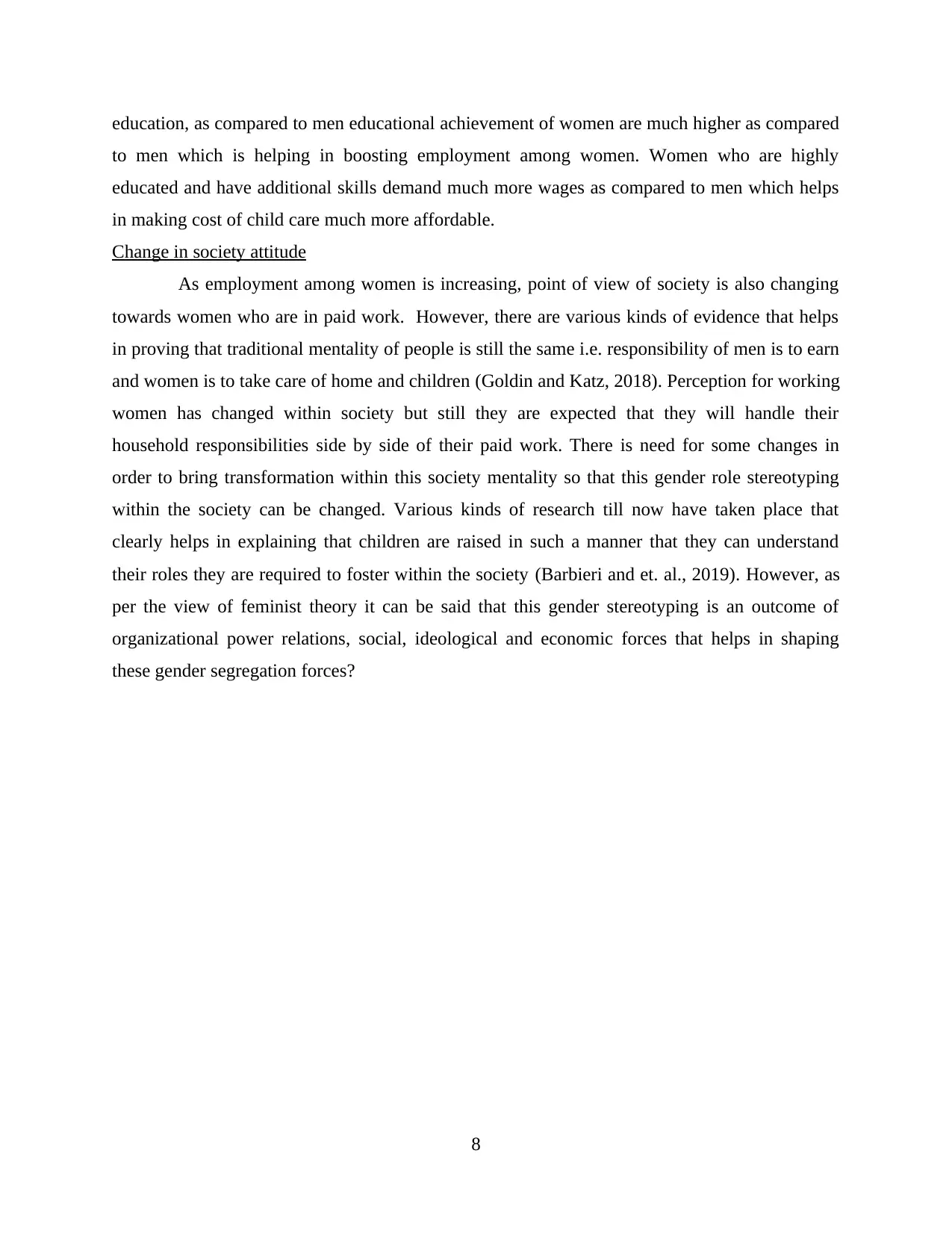
education, as compared to men educational achievement of women are much higher as compared
to men which is helping in boosting employment among women. Women who are highly
educated and have additional skills demand much more wages as compared to men which helps
in making cost of child care much more affordable.
Change in society attitude
As employment among women is increasing, point of view of society is also changing
towards women who are in paid work. However, there are various kinds of evidence that helps
in proving that traditional mentality of people is still the same i.e. responsibility of men is to earn
and women is to take care of home and children (Goldin and Katz, 2018). Perception for working
women has changed within society but still they are expected that they will handle their
household responsibilities side by side of their paid work. There is need for some changes in
order to bring transformation within this society mentality so that this gender role stereotyping
within the society can be changed. Various kinds of research till now have taken place that
clearly helps in explaining that children are raised in such a manner that they can understand
their roles they are required to foster within the society (Barbieri and et. al., 2019). However, as
per the view of feminist theory it can be said that this gender stereotyping is an outcome of
organizational power relations, social, ideological and economic forces that helps in shaping
these gender segregation forces?
8
to men which is helping in boosting employment among women. Women who are highly
educated and have additional skills demand much more wages as compared to men which helps
in making cost of child care much more affordable.
Change in society attitude
As employment among women is increasing, point of view of society is also changing
towards women who are in paid work. However, there are various kinds of evidence that helps
in proving that traditional mentality of people is still the same i.e. responsibility of men is to earn
and women is to take care of home and children (Goldin and Katz, 2018). Perception for working
women has changed within society but still they are expected that they will handle their
household responsibilities side by side of their paid work. There is need for some changes in
order to bring transformation within this society mentality so that this gender role stereotyping
within the society can be changed. Various kinds of research till now have taken place that
clearly helps in explaining that children are raised in such a manner that they can understand
their roles they are required to foster within the society (Barbieri and et. al., 2019). However, as
per the view of feminist theory it can be said that this gender stereotyping is an outcome of
organizational power relations, social, ideological and economic forces that helps in shaping
these gender segregation forces?
8
Paraphrase This Document
Need a fresh take? Get an instant paraphrase of this document with our AI Paraphraser
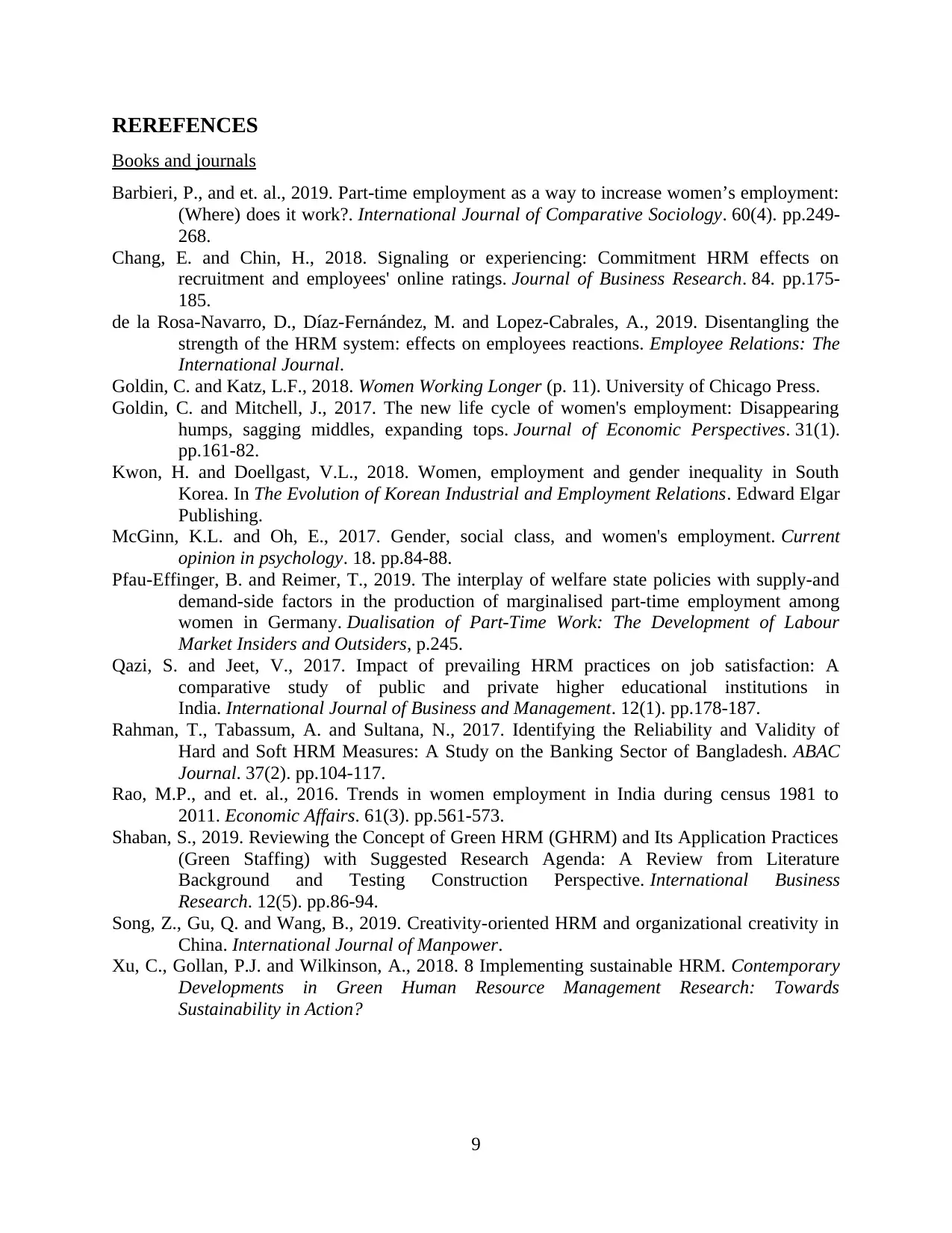
REREFENCES
Books and journals
Barbieri, P., and et. al., 2019. Part-time employment as a way to increase women’s employment:
(Where) does it work?. International Journal of Comparative Sociology. 60(4). pp.249-
268.
Chang, E. and Chin, H., 2018. Signaling or experiencing: Commitment HRM effects on
recruitment and employees' online ratings. Journal of Business Research. 84. pp.175-
185.
de la Rosa-Navarro, D., Díaz-Fernández, M. and Lopez-Cabrales, A., 2019. Disentangling the
strength of the HRM system: effects on employees reactions. Employee Relations: The
International Journal.
Goldin, C. and Katz, L.F., 2018. Women Working Longer (p. 11). University of Chicago Press.
Goldin, C. and Mitchell, J., 2017. The new life cycle of women's employment: Disappearing
humps, sagging middles, expanding tops. Journal of Economic Perspectives. 31(1).
pp.161-82.
Kwon, H. and Doellgast, V.L., 2018. Women, employment and gender inequality in South
Korea. In The Evolution of Korean Industrial and Employment Relations. Edward Elgar
Publishing.
McGinn, K.L. and Oh, E., 2017. Gender, social class, and women's employment. Current
opinion in psychology. 18. pp.84-88.
Pfau-Effinger, B. and Reimer, T., 2019. The interplay of welfare state policies with supply-and
demand-side factors in the production of marginalised part-time employment among
women in Germany. Dualisation of Part-Time Work: The Development of Labour
Market Insiders and Outsiders, p.245.
Qazi, S. and Jeet, V., 2017. Impact of prevailing HRM practices on job satisfaction: A
comparative study of public and private higher educational institutions in
India. International Journal of Business and Management. 12(1). pp.178-187.
Rahman, T., Tabassum, A. and Sultana, N., 2017. Identifying the Reliability and Validity of
Hard and Soft HRM Measures: A Study on the Banking Sector of Bangladesh. ABAC
Journal. 37(2). pp.104-117.
Rao, M.P., and et. al., 2016. Trends in women employment in India during census 1981 to
2011. Economic Affairs. 61(3). pp.561-573.
Shaban, S., 2019. Reviewing the Concept of Green HRM (GHRM) and Its Application Practices
(Green Staffing) with Suggested Research Agenda: A Review from Literature
Background and Testing Construction Perspective. International Business
Research. 12(5). pp.86-94.
Song, Z., Gu, Q. and Wang, B., 2019. Creativity-oriented HRM and organizational creativity in
China. International Journal of Manpower.
Xu, C., Gollan, P.J. and Wilkinson, A., 2018. 8 Implementing sustainable HRM. Contemporary
Developments in Green Human Resource Management Research: Towards
Sustainability in Action?
9
Books and journals
Barbieri, P., and et. al., 2019. Part-time employment as a way to increase women’s employment:
(Where) does it work?. International Journal of Comparative Sociology. 60(4). pp.249-
268.
Chang, E. and Chin, H., 2018. Signaling or experiencing: Commitment HRM effects on
recruitment and employees' online ratings. Journal of Business Research. 84. pp.175-
185.
de la Rosa-Navarro, D., Díaz-Fernández, M. and Lopez-Cabrales, A., 2019. Disentangling the
strength of the HRM system: effects on employees reactions. Employee Relations: The
International Journal.
Goldin, C. and Katz, L.F., 2018. Women Working Longer (p. 11). University of Chicago Press.
Goldin, C. and Mitchell, J., 2017. The new life cycle of women's employment: Disappearing
humps, sagging middles, expanding tops. Journal of Economic Perspectives. 31(1).
pp.161-82.
Kwon, H. and Doellgast, V.L., 2018. Women, employment and gender inequality in South
Korea. In The Evolution of Korean Industrial and Employment Relations. Edward Elgar
Publishing.
McGinn, K.L. and Oh, E., 2017. Gender, social class, and women's employment. Current
opinion in psychology. 18. pp.84-88.
Pfau-Effinger, B. and Reimer, T., 2019. The interplay of welfare state policies with supply-and
demand-side factors in the production of marginalised part-time employment among
women in Germany. Dualisation of Part-Time Work: The Development of Labour
Market Insiders and Outsiders, p.245.
Qazi, S. and Jeet, V., 2017. Impact of prevailing HRM practices on job satisfaction: A
comparative study of public and private higher educational institutions in
India. International Journal of Business and Management. 12(1). pp.178-187.
Rahman, T., Tabassum, A. and Sultana, N., 2017. Identifying the Reliability and Validity of
Hard and Soft HRM Measures: A Study on the Banking Sector of Bangladesh. ABAC
Journal. 37(2). pp.104-117.
Rao, M.P., and et. al., 2016. Trends in women employment in India during census 1981 to
2011. Economic Affairs. 61(3). pp.561-573.
Shaban, S., 2019. Reviewing the Concept of Green HRM (GHRM) and Its Application Practices
(Green Staffing) with Suggested Research Agenda: A Review from Literature
Background and Testing Construction Perspective. International Business
Research. 12(5). pp.86-94.
Song, Z., Gu, Q. and Wang, B., 2019. Creativity-oriented HRM and organizational creativity in
China. International Journal of Manpower.
Xu, C., Gollan, P.J. and Wilkinson, A., 2018. 8 Implementing sustainable HRM. Contemporary
Developments in Green Human Resource Management Research: Towards
Sustainability in Action?
9
1 out of 11
Related Documents
Your All-in-One AI-Powered Toolkit for Academic Success.
+13062052269
info@desklib.com
Available 24*7 on WhatsApp / Email
![[object Object]](/_next/static/media/star-bottom.7253800d.svg)
Unlock your academic potential
Copyright © 2020–2025 A2Z Services. All Rights Reserved. Developed and managed by ZUCOL.



